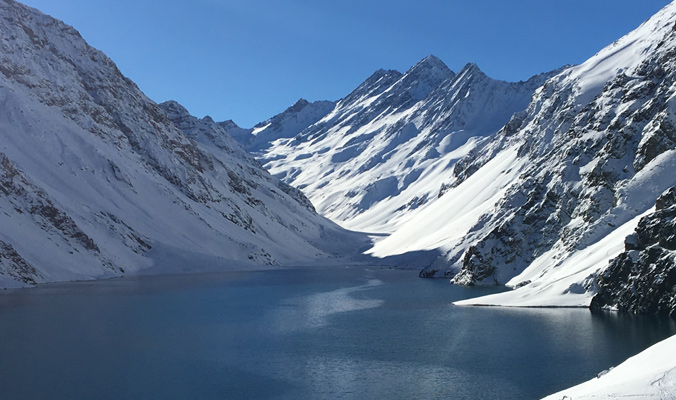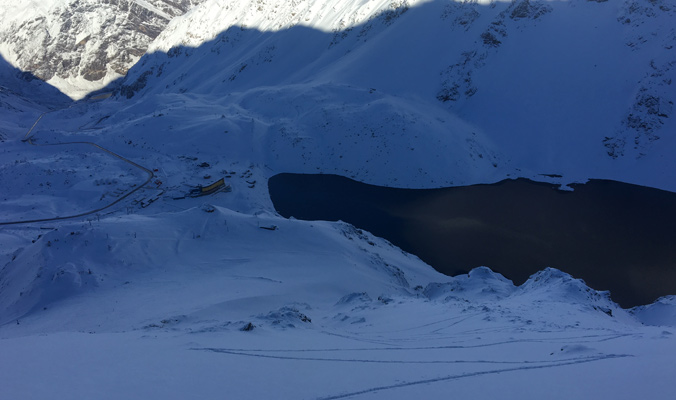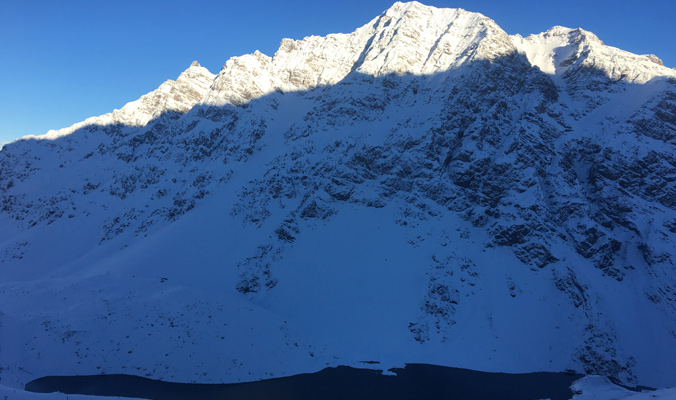
Laguna del Inca welcomes both movie stars and bc tourers. [Photo] Greg Scruggs

The road to Portillo requires some kickturns. [Photo] Greg Scruggs
Tantalizing high-alpine objectives, like the legendary Super C, ring the valley surrounding the resort. With my early season trip, just the second week of operation at Portillo, I had no expectation of finding anything as gnarly as the Super C filled in. Indeed, the best backcountry offerings were closed runs that would normally be inbounds. But the secluded nature of Portillo—just a single resort with no town or other human presence nearby other than the border crossing a mile up the road—made even my quick skins away from the open piste a marvel of Andean scenery and some pretty tasty pow. What’s more: there were no other backcountry users in sight.
One of my full days was socked in, so Assistant Snow Safety Director Frédéric Valvo took me on a low-visibility climb up the route of El Caracara, one of the resort’s famed custom-made Poma tow ropes. We then traversed across a rock band and grabbed first-of-the-season tracks on Kilómetro Lanzado, eventually bottoming out at Los Caracoles and hitching a ride on a Portillo van that scoops up skiers when the lower-elevation Juncalillo lift isn’t running.
That night I skipped the disco—another draw for the high-brow skiing set—and the next day I seized a bluebird morning for a dawn patrol mission while everyone else was still sleeping off their hangovers. The day before I had gone looker’s left of the lake, so I opted for looker’s right as a new option. I skinned up the corduroy of the Las Lomas groomer and made my way to Tio Bob’s, the popular on-mountain lunch spot. I cranked up my heel risers for the steep pitch of a Va et Vient route, and then traversed out of bounds. I kept climbing until the snow thinned and transitioned for a solid 2,000-foot descent that eventually picked up the inbounds—but closed—Lake Run. The sun was just beginning to strike the immense peaks of the Andes as I carved my way down. The lake loomed in front of me, and I stopped just short of the water and picked up the cat track along the lake’s edge that led back to Portillo.

View from the top of the skintrack above the lodge at Portillo. [Photo] Greg Scruggs
At the same time, the backcountry remains relatively unexplored in the high country of Chile and Argentina. In Portillo, posted signage warnings of out-of-bounds risks come with a lax, hands-off policy akin to those found in Europe: off-piste travel is fine but at your own risk, and there are no North American-style gates or waivers to make you think about the consequences of your actions.
Search and rescue is pretty much limited to Portillo’s own ski patrol. The Chilean army mans the nearby border checkpoint, but they have limited capacity and no avalanche training. “If you go out of the area, you’re on your own,” say Coffey, who spends his North American winters in Crested Butte. “If something does happen, we’ll do our best,” he adds. Add in above-treeline terrain that can be disorienting if the clouds roll in, and it’s not a scenario where “sidecountry” shortcuts to safety are a given.
What’s more, there is no Chilean avalanche information center, and even Los Caracoles has no dedicated avalanche forecast. Chilean transportation officials err on the side of the caution, with road closures a common occurrence, and the resort posts a daily avalanche forecast with an occasional upload to Avanet, but Coffey hasn’t found it to be a very popular tool in the area. As an example of the lack of digital communication, Coffey tells me that when freeride athlete Matilda Rapaport perished in an avalanche last year at La Parva, very little was done in the way of communicating accident report to better inform forecasters and tourers trying to understand the nuances of the Andean snowpack.

Laguna del Inca below towering Andean peaks. [Photo] Greg Scruggs
“The backcountry community is just starting,” Valvo mentioned, but there are encouraging signs of growth. “There’s a culture of paying for education; resorts are too expensive, but people are willing to pay for a course,” he explained. AIARE has been offering avalanche safety courses in South America for five years now, and in August AIARE taught their first Level 3 course for snow safety professionals.
Then there’s the elevation barrier. Charging out of the gate at 10,000 feet took it out of me. “There’s always a Brazilian who comes from sea level and wants to hike Super C with his snowboard because he’s seen it in a video, but he never makes it past Roca Jack,” Valvo says laughing. So with slowly evolving avalanche resources and an extreme lack of oxygen, it may be a while before the Portillo touring scene explodes. Until then, the intrepid few will be able to skin above the crystal blue waters of the Laguna del Inca in peace.










Related posts: